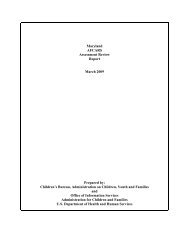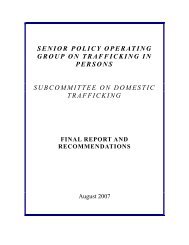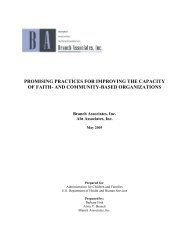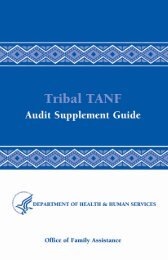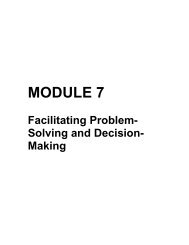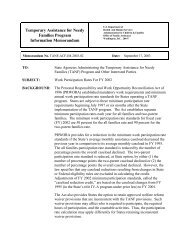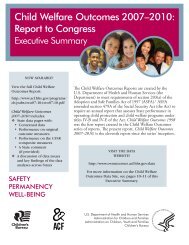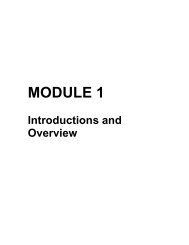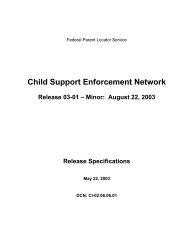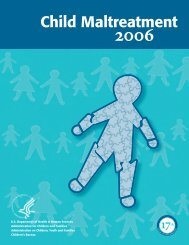pdf 259kb - Administration for Children and Families
pdf 259kb - Administration for Children and Families
pdf 259kb - Administration for Children and Families
You also want an ePaper? Increase the reach of your titles
YUMPU automatically turns print PDFs into web optimized ePapers that Google loves.
DEPARTMENT OF HEALTH AND HUMAN SERVICESADMINISTRATION FOR CHILDREN AND FAMILIESTEMPORARY ASSISTANCE FOR NEEDY FAMILIESTABLE OF CONTENTSFY 2009 BUDGETPAGEAUTHORIZING LEGISLATION ....................................................................................................... J-3APPROPRIATION HISTORY TABLE ............................................................................................... J-5AMOUNTS AVAILABLE FOR OBLIGATION .................................................................................... J-6BUDGET AUTHORITY BY ACTIVITY ............................................................................................. J-6JUSTIFICATION:GENERAL STATEMENT .............................................................................................................. J-7PROGRAM DESCRIPTION AND ACCOMPLISHMENTS .............................................................. J-8BUDGET REQUEST .................................................................................................................. J-11OUTPUTS AND OUTCOMES TABLE ......................................................................................... J-12RESOURCE AND PROGRAM DATA ............................................................................................. J-14STATE TABLES ........................................................................................................................... J-19<strong>Administration</strong> <strong>for</strong> <strong>Children</strong> <strong>and</strong> <strong>Families</strong> Page J-1Justification of Estimates <strong>for</strong> Appropriations CommitteeTemporary Assistance <strong>for</strong> Needy <strong>Families</strong>
This page intentionally left blank.<strong>Administration</strong> <strong>for</strong> <strong>Children</strong> <strong>and</strong> <strong>Families</strong> Page J-2Justification of Estimates <strong>for</strong> Appropriations CommitteeTemporary Assistance <strong>for</strong> Needy <strong>Families</strong>
FY 2008AmountAuthorizedFY 2008BudgetEstimateFY 2009AmountAuthorizedFY 2009BudgetRequest 1Total request level $17,058,625,000 $17,058,625,000Total request level $17,058,625,287 $17,08,625,000 $17,058,625,287 $17,058,625,000authorization 3against definite3While the authorizations above indicate such sums were authorized in the Deficit Reduction Act of 2005 (DRA), the DRA language alsostipulates that the funding level <strong>for</strong> TANF activities are authorized at the fiscal year 2004 levels through fiscal year 2010, with the exception ofSupplemental Grants <strong>for</strong> Population Increases, which is authorized through FY 2008.<strong>Administration</strong> <strong>for</strong> <strong>Children</strong> <strong>and</strong> <strong>Families</strong> Page J-4Justification of Estimates <strong>for</strong> Appropriations CommitteeTemporary Assistance <strong>for</strong> Needy <strong>Families</strong>
ADMINISTRATION FOR CHILDREN AND FAMILIESTemporary Assistance <strong>for</strong> Needy <strong>Families</strong>APPROPRIATIONS HISTORY TABLEYear Appropriation1999 $16,689,175,2871999 – multi-year 1,000,000,000 12000 16,689,175,2872001 16,689,175,2872002 17,008,625,287 22003 17,008,625,513 32004 17,008,625,513 32005 17,008,625,513 32005/6 5,139,108,000 32005/6 11,988,328,513 42007 17,058,625,5132008 17,058,625,5132009 17,058,625,5131 Congress appropriated a total of $1 billion in FY 1999 <strong>for</strong> High Per<strong>for</strong>mance Bonus grants <strong>for</strong> fiscal years 1999 through 2003. Congressappropriated $200 million per year <strong>for</strong> 2004 & 2005 <strong>for</strong> High Per<strong>for</strong>mance Bonus grants.2 Congress appropriated $319 million <strong>for</strong> Supplemental Grants <strong>for</strong> 2002, 2003, 2004 <strong>and</strong> 2005 as part of the basic program.3 The TANF Emergency Response <strong>and</strong> Recovery Act of 2005 was enacted late in FY 2005 <strong>and</strong> made $5.1 billion in FY 2006 1 st quarter fundsavailable immediately to states, territories <strong>and</strong> tribes <strong>for</strong> family assistance grants <strong>and</strong> Federal Loans to the states of Louisiana, Mississippi <strong>and</strong>Alabama to assist them in providing services to Hurricane Katrina evacuees.3 Same as above.3 Same as above.3 Same as above.4 The Deficit Reduction Act of 2005 provided the remaining three quarters worth of TANF FY 2006 funding, eliminated the High Per<strong>for</strong>mance<strong>and</strong> Out of Wedlock Bonus funding <strong>and</strong> added new authority <strong>for</strong> $150 million <strong>for</strong> Healthy Marriage <strong>and</strong> Responsible Fatherhood Grants.<strong>Administration</strong> <strong>for</strong> <strong>Children</strong> <strong>and</strong> <strong>Families</strong> Page J-5Justification of Estimates <strong>for</strong> Appropriations CommitteeTemporary Assistance <strong>for</strong> Needy <strong>Families</strong>
ADMINISTRATION FOR CHILDREN AND FAMILIESTemporary Assistance <strong>for</strong> Needy <strong>Families</strong>FY 2007EnactedJustificationFY 2008EnactedFY 2009EstimateIncrease orDecreaseBudget Authority $17,058,625,000 $17,058,625,000 $17,058,625,000 $0Authorizing Legislation ─ Section 403(a), 403(b), 412(a) <strong>and</strong> 1108 of the Social Security Act.2009 Authorization………$17,058,625,000 (TANF pre-appropriated authority) <strong>and</strong> such sums as carried<strong>for</strong>ward as unobligated balances from the previous year <strong>for</strong> the Contingency Fund.Allocation Method ................................................................................... Formula Grant/Competitive GrantGeneral StatementTitle I of P.L. 104-193, the Personal Responsibility <strong>and</strong> Work Opportunity Reconciliation Act of 1996(PRWORA), created the Temporary Assistance <strong>for</strong> Needy <strong>Families</strong> (TANF) program. The legislationrepealed the Aid to <strong>Families</strong> with Dependent <strong>Children</strong> (AFDC) <strong>and</strong> related programs <strong>and</strong> replaced themwith a single fixed block grant. The purpose of the TANF program is to increase state flexibility inoperating programs designed to: (1) provide assistance to needy families so that children may be cared<strong>for</strong> in their own homes; (2) end dependence of needy parents by promoting job preparation, work, <strong>and</strong>marriage; (3) prevent <strong>and</strong> reduce the incidence of out-of-wedlock pregnancies; <strong>and</strong> (4) encourage the<strong>for</strong>mation <strong>and</strong> maintenance of two-parent families.The Deficit Reduction Act of 2005 (DRA), Public Law 109-171, addressed several critical Presidentialinitiatives impacting the TANF program. The DRA: (1) reauthorized the TANF program through 2010<strong>and</strong> maintained program funding levels <strong>for</strong> Family Assistance Grants to States, Tribes <strong>and</strong> Territories;Matching Grants to Territories; Tribal Work Programs; <strong>and</strong> allowed continued access to the ContingencyFund; (2) strengthened work participation requirements; (3) created <strong>and</strong> provided funds <strong>for</strong> a programfocused on promotion of healthy marriage <strong>and</strong> responsible fatherhood; (4) reinstated authority <strong>for</strong> theSupplemental Grants <strong>for</strong> Population Increases program through FY 2008; <strong>and</strong> (5) eliminated funding <strong>for</strong>both the Bonus to Reward High Per<strong>for</strong>mance States <strong>and</strong> the Bonus to Reward Decreases in Illegitimacy.In order to strengthen work participation, the DRA recalibrated the caseload reduction credit by updatingthe base year from 1995 to 2005 – thereby reestablishing a meaningful family work participation raterequirement. Prior to this time, most states had a zero or nearly zero target rate <strong>for</strong> parents participatingin work activities. Additionally, the current statutory provision <strong>for</strong> a separate participation raterequirement <strong>for</strong> 2-parent families was retained <strong>and</strong>, in FY 2007, families receiving assistance in SeparateState Programs (SSP) were included in the calculation of work participation rates. The DRA alsorequired HHS to issue regulations to ensure consistency in measuring work participation rates with regardto determining whether activities may be counted as “work activities,” how to count <strong>and</strong> verify hours ofwork, <strong>and</strong> determining who is a work-eligible individual. Further, the DRA required states to establish<strong>and</strong> maintain work participation verification procedures <strong>and</strong> established a new penalty (of not less than<strong>Administration</strong> <strong>for</strong> <strong>Children</strong> <strong>and</strong> <strong>Families</strong> Page J-7Justification of Estimates <strong>for</strong> Appropriations CommitteeTemporary Assistance <strong>for</strong> Needy <strong>Families</strong>
one percent <strong>and</strong> not more than five percent of the state family assistance grant) <strong>for</strong> state failure to complywith these procedures.The DRA also includes $150 million <strong>for</strong> a comprehensive program focused on the promotion of healthymarriage <strong>and</strong> responsible fatherhood, which are areas that the <strong>Administration</strong> has long considered vital toensuring that welfare re<strong>for</strong>m continues to place a greater emphasis on strengthening families <strong>and</strong>improving the well-being of children. The Healthy Marriage <strong>and</strong> Responsible Fatherhood Grantsprogram funding supports several key ef<strong>for</strong>ts specified in the statute, including healthy marriage <strong>and</strong>responsible fatherhood activities, demonstrations coordinating child welfare <strong>and</strong> TANF <strong>for</strong> at-risk tribalfamilies, <strong>and</strong> technical assistance provided to states <strong>and</strong> tribes.The FY 2009 President’s Budget estimate of $17,058,625,000 <strong>for</strong> the TANF program <strong>and</strong> the estimatedunobligated balances carried <strong>for</strong>ward in the Contingency Fund included current law requirements <strong>and</strong> theproposed law extension of the Supplemental Grants <strong>for</strong> Population Increases program.Program Description <strong>and</strong> AccomplishmentsState Family Assistance Grants – Funding under the TANF program is provided primarily through StateFamily Assistance Grants, which are authorized <strong>and</strong> pre-appropriated at $16.5 billion each year. Stateallocations are based on historic levels of welfare spending. While states must meet certain workparticipation <strong>and</strong> maintenance of ef<strong>for</strong>t requirements, they have enormous flexibility with their TANFfunds to design programs that promote work, personal responsibility <strong>and</strong> self-sufficiency, <strong>and</strong> strengthenfamilies.States have wide flexibility under TANF to determine their own eligibility criteria, benefit levels, <strong>and</strong> thetype of services <strong>and</strong> benefits available to TANF recipients. However, states must maintain a historicallevel of state spending on behalf of eligible families (the maintenance of ef<strong>for</strong>t requirement) <strong>and</strong> mustmeet minimum work participation rate requirements. In addition, families who have received federallyfunded assistance under TANF <strong>for</strong> five cumulative years (or less at state option) are not eligible <strong>for</strong>federally funded assistance.States may transfer up to a total of 30 percent of their TANF funds to either the Child Care <strong>and</strong>Development Block Grant program or the Social Services Block Grant (SSBG) program with not morethan 10 percent transferable to SSBG.Tribes are eligible to operate their own TANF programs <strong>and</strong> those that choose to do so receive their ownFamily Assistance Grants. The number of approved tribal TANF plans has steadily increased since thefirst three tribal TANF programs started in July 1997. As of October 1, 2007, there were 55 tribal TANFgrantees (48 individual tribes, 4 Alaska Native Regional Non-profits, <strong>and</strong> 3 consortia) covering 267 tribes<strong>and</strong> Alaska Native Villages, the non-reservation American Indian/Alaska Native populations of 105counties, several near-reservation towns, <strong>and</strong> the Municipality of Anchorage, Alaska have been approved,all of which are fully operational. Forty-four of the approved plans involve individual tribes <strong>and</strong> 11 aremulti-tribal TANF operations.Territory -- Family Assistance Grants – These grants provide funding to Guam, Puerto Rico <strong>and</strong> theVirgin Isl<strong>and</strong>s to operate their own TANF programs. Territories are subject to the same state plan, work,<strong>and</strong> maintenance of ef<strong>for</strong>t requirements as the fifty states <strong>and</strong> the District of Columbia. A territory'sallocation is based on historic funding levels, with a total of $77.9 million made available annually.Matching Grants to Territories – These grants are an additional source of funding to the territories. TheseMatching Grants are subject to a ceiling under Section 1108 of the Social Security Act <strong>and</strong> additional<strong>Administration</strong> <strong>for</strong> <strong>Children</strong> <strong>and</strong> <strong>Families</strong> Page J-8Justification of Estimates <strong>for</strong> Appropriations CommitteeTemporary Assistance <strong>for</strong> Needy <strong>Families</strong>
maintenance of ef<strong>for</strong>t requirements. Matching Grant funds may be used <strong>for</strong> the TANF program <strong>and</strong> theFoster Care, Adoption Assistance, <strong>and</strong> Independent Living programs. The federal matching rate <strong>for</strong> thesefunds is 75 percent, <strong>and</strong> up to $15 million is made available annually <strong>for</strong> this purpose. Use of theMatching Grant is optional.Supplemental Grants <strong>for</strong> Population Increases – These grants provide additional TANF funding to statesthat experienced increases in their populations <strong>and</strong>/or had low levels of welfare spending per capita. Astate qualified <strong>for</strong> a grant in years after FY 1998 only if it qualified in FY 1998. Territories <strong>and</strong> Tribes arenot eligible. Seventeen states received a total of $319 million <strong>for</strong> these grants in FY 2007. The DeficitReduction Act provides authority <strong>for</strong> these grants at the FY 2005 level through the end of FY 2008.Healthy Marriage Promotion <strong>and</strong> Responsible Fatherhood Grants – The DRA included $150 million <strong>for</strong>the Healthy Marriage Promotion <strong>and</strong> Responsible Fatherhood Grant program beginning in FY 2006. InFY 2007, the Healthy Marriage portion of the initiative was funded at approximately $94.6 million tohelp couples, who have chosen marriage <strong>for</strong> themselves, gain greater access to marriage educationservices on a voluntary basis. These services will help couples acquire the skills <strong>and</strong> knowledgenecessary to <strong>for</strong>m <strong>and</strong> sustain a healthy marriage. ACF has awarded these funds on a competitive basis tostates, territories, Indian tribes <strong>and</strong> tribal organizations, <strong>and</strong> public <strong>and</strong> nonprofit community entities(including religious organizations) <strong>for</strong> activities promoting healthy marriage. All grantees must includedocumentation to demonstrate that the funds will not be used <strong>for</strong> other purposes <strong>and</strong> that they intend toconsult with experts in domestic violence or relevant community domestic violence coalitions indeveloping the programs <strong>and</strong> activities. The law stipulates that the term “healthy marriage promotionactivities” may include the following activities: (1) Public advertising campaigns on the value of marriage<strong>and</strong> the skills needed to increase marital stability <strong>and</strong> health; (2) Education in high schools on the value ofmarriage, relationship skills, <strong>and</strong> budgeting; (3) Marriage education, marriage skills, <strong>and</strong> relationshipskills programs that may include parenting skills, financial management, conflict resolution, <strong>and</strong> job <strong>and</strong>career advancement <strong>for</strong> non-married pregnant women <strong>and</strong> non-married expectant fathers; (4) Pre-maritaleducation <strong>and</strong> marriage skills training <strong>for</strong> engaged couples <strong>and</strong> <strong>for</strong> couples or individuals interested inmarriage; (5) Marriage enhancement <strong>and</strong> marriage skills training programs <strong>for</strong> married couples; (6)Divorce reduction programs that teach relationship skills; (7) Marriage mentoring programs which usemarried couples as role models <strong>and</strong> mentors in at-risk communities; or (8) Programs to reduce thedisincentives to marriage in means-tested aid programs, if offered in conjunction with any other activitylisted above.Within the Healthy Marriage Promotion <strong>and</strong> Responsible Fatherhood funding, approximately $44.2million was made available during FY 2007, <strong>for</strong> activities specifically designed to promote responsiblefatherhood to reverse the rise in father absence <strong>and</strong> its subsequent impact on our nation's children. ACFhas awarded these funds on a competitive basis to states, Indian tribes <strong>and</strong> tribal organizations, <strong>and</strong> public<strong>and</strong> nonprofit community entities (including religious organizations) <strong>for</strong> activities promoting responsiblefatherhood. The statute defines activities promoting responsible fatherhood as the following:• Activities to promote marriage or sustain marriage through activities such as counseling,mentoring, disseminating in<strong>for</strong>mation about the benefits of marriage <strong>and</strong> two-parent involvement<strong>for</strong> children, enhancing relationship skills, education regarding how to control aggressivebehavior, disseminating in<strong>for</strong>mation on the causes of domestic violence <strong>and</strong> child abuse, marriagepreparation programs, premarital counseling, marital inventories, skills-based marriage education,financial planning seminars, including improving a family's ability to effectively manage familybusiness affairs by means such as education, counseling, or mentoring on matters related tofamily finances, including household management, budgeting, banking, <strong>and</strong> h<strong>and</strong>ling of financialtransactions <strong>and</strong> home maintenance, <strong>and</strong> divorce education <strong>and</strong> reduction programs, includingmediation <strong>and</strong> counseling.<strong>Administration</strong> <strong>for</strong> <strong>Children</strong> <strong>and</strong> <strong>Families</strong> Page J-9Justification of Estimates <strong>for</strong> Appropriations CommitteeTemporary Assistance <strong>for</strong> Needy <strong>Families</strong>
• Activities to promote responsible parenting through activities such as counseling, mentoring, <strong>and</strong>mediation, disseminating in<strong>for</strong>mation about good parenting practices, skills-based parentingeducation, encouraging child support payments, <strong>and</strong> other methods.• Activities to foster economic stability by helping fathers improve their economic status byproviding activities such as work first services, job search, job training, subsidized employment,job retention, job enhancement, <strong>and</strong> encouraging education, including career-advancingeducation, dissemination of employment materials, coordination with existing employmentservices such as welfare-to-work programs, referrals to local employment training initiatives, <strong>and</strong>other methods.• Activities to promote responsible fatherhood that are conducted through a contract with anationally recognized, nonprofit fatherhood promotion organization, such as the development,promotion, <strong>and</strong> distribution of a media campaign to encourage the appropriate involvement ofparents in the life of any child <strong>and</strong> specifically the issue of responsible fatherhood, <strong>and</strong> thedevelopment of a national clearinghouse to assist states <strong>and</strong> communities in ef<strong>for</strong>ts to promote<strong>and</strong> support marriage <strong>and</strong> responsible fatherhood.In addition, during FY 2007 approximately $1.6 million of the Healthy Marriage <strong>and</strong> ResponsibleFatherhood funding was made available to fund on a competitive basis demonstration projects designed totest the effectiveness of tribal governments or tribal consortia in coordinating the provision to tribalfamilies at risk of child abuse or neglect of child welfare services <strong>and</strong> services under tribal programsfunded under Part IV-A of the Social Security Act. The statute stipulates that grants shall be used toimprove case management <strong>for</strong> families eligible <strong>for</strong> assistance from such a tribal program; <strong>for</strong> supportiveservices <strong>and</strong> assistance to tribal children in out-of-home placements <strong>and</strong> the tribal families caring <strong>for</strong> suchchildren, including families who adopt such children; <strong>and</strong> <strong>for</strong> prevention services <strong>and</strong> assistance to tribalfamilies at risk of child abuse <strong>and</strong> neglect.Finally, approximately $9.6 million of the FY 2007 Healthy Marriage <strong>and</strong> Responsible Fatherhoodfunding was used to provide broad technical assistance to states, Indian tribes <strong>and</strong> tribal organizationsreceiving a grant <strong>for</strong> any program funded under Part IV-A of the Social Security Act.Tribal Work Programs – These grants are available to Indian tribes <strong>and</strong> Alaska Native organizationsthat conducted a Job Opportunities <strong>and</strong> Basic Skills Training (JOBS) program in FY 1995. Thepurpose of these grants is to allow Indian tribes <strong>and</strong> Alaska Native organizations to operate a programto make work activities available to their members. Funding is authorized <strong>and</strong> pre-appropriated at$7.6 million <strong>for</strong> each fiscal year.Contingency Fund – The Contingency Fund provides a funding reserve which can be used to assiststates that experience economic downturns. In order to be eligible to receive Contingency Funds, astate must meet one of two criteria:1) The state’s unemployment rate <strong>for</strong> the most recent 3-month period <strong>for</strong> which data are available mustexceed 6.5 percent <strong>and</strong> this rate must be at least 10 percent higher than the unemployment rate <strong>for</strong> thesame 3-month period in either or both of the last two calendar years or;2) The number of food stamp participants in the state must exceed by at least 10 percent the number offood stamp participants in the state in the comparable quarter of either FY 1994 or FY 1995.<strong>Administration</strong> <strong>for</strong> <strong>Children</strong> <strong>and</strong> <strong>Families</strong> Page J-10Justification of Estimates <strong>for</strong> Appropriations CommitteeTemporary Assistance <strong>for</strong> Needy <strong>Families</strong>
The reauthorized level <strong>for</strong> the Contingency Fund through 2010 retained the above triggers <strong>and</strong> providedfunding at current unobligated balance levels ($1.7 billion in FY 2007).A PART review was conducted in CY 2005 <strong>and</strong> the TANF program received a rating of ModeratelyEffective. This review found that the program has produced statistically significant increases inemployment <strong>and</strong> earnings among welfare recipients, as well as reduced caseloads, poverty, <strong>and</strong> welfaredependency. As a result of the PART review, the program is reassessing its per<strong>for</strong>mance measures toimprove strategic planning, is working with states to reduce improper payments, <strong>and</strong> has developed anOMB-approved efficiency measure.States have had considerable success in moving TANF recipients to work <strong>and</strong> helping them retainemployment. ACF exceeded its per<strong>for</strong>mance target <strong>for</strong> job entry <strong>and</strong> job retention in FY 2006. The jobentry rate was nearly 36 percent, which exceeded the target <strong>and</strong> was over a percentage point higher thanthe previous year’s result. In addition, the job retention rate was nearly 65 percent, which exceeded thetarget of 61 percent. Targets <strong>for</strong> job entry <strong>and</strong> job retention were recalibrated in CY 2005 to moreaccurately reflect program circumstances <strong>and</strong> trend data. The DRA <strong>and</strong> implementing regulations clearlysignaled that states needed to renew ef<strong>for</strong>ts to move TANF recipients into employment/work activities orface significant fiscal penalties, which should positively impact these work per<strong>for</strong>mance measures.Budget Request – The FY 2009 request is $17,058,625,000, the same as the 2008 enacted level. The<strong>Administration</strong> continues to propose extending authority <strong>and</strong> funding <strong>for</strong> the Supplemental Grants <strong>for</strong>Population Increases program beyond FY 2008 <strong>and</strong> through FY 2010. This extension will make theSupplemental Grants <strong>for</strong> Population Increases program consistent with the other components of theTANF program. The <strong>Administration</strong> continues to support eliminating the separate two-parent 90 percentwork requirement established under PRWORA to encourage equitable treatment of all families throughthe overall 50 percent work requirement.The TANF program will calculate preliminary full-year FY 2007 work participation rates to determineper<strong>for</strong>mance relative to adjusted state targets <strong>and</strong> adjusted per<strong>for</strong>mance targets by March 30, 2008, <strong>and</strong>plans to have final rates available shortly thereafter. By FY 2009, the program expects that 90 percent ofstates will meet the work participation rate.<strong>Administration</strong> <strong>for</strong> <strong>Children</strong> <strong>and</strong> <strong>Families</strong> Page J-11Justification of Estimates <strong>for</strong> Appropriations CommitteeTemporary Assistance <strong>for</strong> Needy <strong>Families</strong>
Outputs <strong>and</strong> Outcomes Table#Key OutcomesFY 2004ActualFY2005ActualFY 2006 FY 2007 FY2008Target Actual Target Actual TargetFY 2009TargetOut-YearTargetLong-Term Objective 22.1: By FY 2010, at least 50 percent of all cases receiving TANF that are headed by adults will participate in work-relatedactivities.All states meet the TANFall-families work22participation rate:FY 2002 – 2005 All100% 98% 100% 98% 80% Oct-08 85% 90% n/aA families work participationrate = 50% workparticipation (outcome)Long-Term Objective 22.2: Increase (from the baseline year FY 1999) the percentage of adult TANF recipients who become newly employed to38 percent by FY 2009.22B22C22D22E22FIncrease the percentage ofadult TANF recipients whobecome newly employed. 1outcome)Increase the percentage ofadult TANFrecipients/<strong>for</strong>mer recipientsemployed in one quarterthat were still employed inthe next two consecutivequarters. (outcome)Increase the percentage rateof earnings gained byemployed adult TANFrecipients/<strong>for</strong>mer recipientsbetween a base quarter <strong>and</strong>a second subsequentquarter. (outcome)Increase the rate of caseclosures related toemployment, child supportcollected, <strong>and</strong> marriage.(outcome)Decrease the annual costper recipient. (OMBapproved efficiency)35.0% 34.3% 35.0% 35.6% 36.0% Oct-08 37.0% 38.0%39%(FY 2012)59.0% 64.4% 61.0% 64.7% 62.0% Oct-08 63.0% 65.0% n/a37.0% 35.5% 38.8% 33.8% 40.7% Oct-08 40.8% 2 40.9% n/a19.6% 20.1% 20.3% 21.6% 20.3% Jul-08 20.8% 21.0% n/a$2,516 $2,619 n/a $3,055 n/a Oct-08Long-Term Objective 22.3: By FY 2010, increase the number of children living in married couple households as a percentage of all childrenliving in households to 74 percent.22GIncrease the number ofchildren living in marriedcouple households as apercentage of all childrenliving in households. 1 3(outcome)2%underprevyear2%underprevyear69% 69% 70% 68% 71% Oct-08 72% 73%n/a74%(FY 2010)1 This measure is a per<strong>for</strong>mance indicator <strong>for</strong> the FY 2007-2012 HHS Strategic Plan.2 The targets <strong>for</strong> FY 2006 <strong>and</strong> FY 2007 reflect an ACF ten percent improvement goal by FY 2007 from the 37 percent base <strong>for</strong> this measure.ACF has increased the target <strong>for</strong> FY 2008 <strong>and</strong> FY 2009 by one tenth of one percent each because the FY 2007 target is rigorous.3 This measure is based on data collected each calendar (not fiscal) year.<strong>Administration</strong> <strong>for</strong> <strong>Children</strong> <strong>and</strong> <strong>Families</strong> Page J-12Justification of Estimates <strong>for</strong> Appropriations CommitteeTemporary Assistance <strong>for</strong> Needy <strong>Families</strong>
#Key OutputsFY 2004ActualFY 2005ActualTarget/Est.FY 2006 FY 2007 FY 2008Target/ActualActual Est.Target/ Est.FY2009Target/ Est.Average monthlynumber of families 1,987,063 1,920,504 n/a 1,807,401 n/a Jun-08 n/a n/a n/areceiving assistanceNumber of familiesmeetingparticipation307,784 296,764 n/a 271,080 n/a Jun-08 n/a n/a n/arequirementsNumber of TANFadult recipients that 257,078 253,348 n/a 215,203 n/a Jun-08 n/a n/a n/aare employedAverage number ofmonths receiving 31.2 33.5 n/a 35.4 n/a Jun-08 n/a n/a n/aTANF assistance 4Pre-AppropriatedAmount($ Million)$17,183.3 $17,284.2 $17,139.7 $17,034.0 $17,058.7 $17,058.7Out-YearTarget/ Est.4 This figure represents the average number of months a family had received TANF assistance by the end of the fiscal year, rather than the totalnumber of months a family may receive assistance be<strong>for</strong>e leaving the program.<strong>Administration</strong> <strong>for</strong> <strong>Children</strong> <strong>and</strong> <strong>Families</strong> Page J-13Justification of Estimates <strong>for</strong> Appropriations CommitteeTemporary Assistance <strong>for</strong> Needy <strong>Families</strong>
Resource <strong>and</strong> Program DataState Family Assistance GrantsFY 2007ActualFY 2008EnactedFY 2009EstimateResource Data:Service GrantsFormula $16,479,811,000 $16,488,667,000 $16,488,667,000DiscretionaryResearch/EvaluationDemonstration/DevelopmentTraining/Technical AssistanceProgram SupportTotal, Resources $16,479,811,000 $16,488,667,000 $16,488,667,000Program Data:Number of Grants 104 104 104New Starts:# 0 0 0$ $0 $0 $0Continuations:# 104 104 104$ $16,479,811,000 $16,488,667,000 $16,488,667,000Contracts:# 0 0 0$ $0 $0 $0Interagency Agreements:# 0 0 0$ $0 $0 $0<strong>Administration</strong> <strong>for</strong> <strong>Children</strong> <strong>and</strong> <strong>Families</strong> Page J-14Justification of Estimates <strong>for</strong> Appropriations CommitteeTemporary Assistance <strong>for</strong> Needy <strong>Families</strong>
Resource <strong>and</strong> Program DataTerritory -- Family Assistance GrantsFY 2007ActualFY 2008EnactedFY 2009EstimateResource Data:Service GrantsFormula $77,229,000 $77,875,000 $77,875,000DiscretionaryResearch/EvaluationDemonstration/DevelopmentTraining/Technical AssistanceProgram SupportTotal, Resources $77,229,000 $77,875,000 $77,875,000Program Data:Number of Grants 3 3 3New Starts:# 0 0 0$ $0 $0 $0Continuations:# 3 3 3$ $77,229,000 $77,875,000 $77,875,000Contracts:# 0 0 0$ $0 $0 $0Interagency Agreements:# 0 0 0$ $0 $0 $0<strong>Administration</strong> <strong>for</strong> <strong>Children</strong> <strong>and</strong> <strong>Families</strong> Page J-15Justification of Estimates <strong>for</strong> Appropriations CommitteeTemporary Assistance <strong>for</strong> Needy <strong>Families</strong>
Resource <strong>and</strong> Program DataSupplemental Grants <strong>for</strong> Population IncreasesFY 2007ActualFY 2008EnactedFY 2009EstimateResource Data:Service GrantsFormula $319,450,000 $319,450,000 $319,450,000DiscretionaryResearch/EvaluationDemonstration/DevelopmentTraining/Technical AssistanceProgram SupportTotal, Resources $319,450,000 $319,450,000 $319,450,000Program Data:Number of Grants 17 17 17New Starts:# 0 0 0$ $0 $0 $0Continuations:# 17 17 17$ $319,450,000 $319,450,000 $319,450,000Contracts:# 0 0 0$ $0 $0 $0Interagency Agreements:# 0 0 0$ $0 $0 $0<strong>Administration</strong> <strong>for</strong> <strong>Children</strong> <strong>and</strong> <strong>Families</strong> Page J-16Justification of Estimates <strong>for</strong> Appropriations CommitteeTemporary Assistance <strong>for</strong> Needy <strong>Families</strong>
Resource <strong>and</strong> Program DataHealthy Marriage Promotion <strong>and</strong> Responsible Fatherhood GrantsFY 2007ActualFY 2008EnactedFY 2009EstimateResource Data:Service GrantsFormulaDiscretionary 1 $115,588,000 $122,004,000 $121,913,000Research/Evaluation 2,000,000 2,000,000 2,000,000Demonstration/Development 14,400,000 14,400,000 14,400,000Training/Technical Assistance 14,666,000 7,692,000 7,726,000Program Support 2 3,308,000 3,904,000 3,961,000Total, Resources $149,962,000 $150,000,000 $150,000,000Program Data:Number of Applicants 0 0 0Number of Grants 235 235 235New Starts:# 0 0 0$ $0 $0 $0Continuations:# 235 235 235$ $115,588,000 $122,004,000 $121,913,000Contracts:# 11 9 10$ $25,992,000 $21,147,000 $19,710,000Interagency Agreements:# 1 2 1$ $2,000,000 $2,260,000 $2,266,0001 Includes $2M to fund demonstration projects focused on coordination of Tribal TANF Child Welfare services to tribal families at risk of childabuse or neglect.2 Includes funding <strong>for</strong> in<strong>for</strong>mation technology support <strong>and</strong> salaries/benefits <strong>and</strong> associated overhead.<strong>Administration</strong> <strong>for</strong> <strong>Children</strong> <strong>and</strong> <strong>Families</strong> Page J-17Justification of Estimates <strong>for</strong> Appropriations CommitteeTemporary Assistance <strong>for</strong> Needy <strong>Families</strong>
Resource <strong>and</strong> Program DataTribal Work ProgramsFY 2007ActualFY 2008EnactedFY 2009EstimateResource Data:Service GrantsFormula $7,551,000 $7,633,287 $7,633,287DiscretionaryResearch/EvaluationDemonstration/DevelopmentTraining/Technical AssistanceProgram SupportTotal, Resources $7,551,000 $7,633,287 $7,633,287Program Data:Number of Grants 55 78 78New Starts:# 0 0 0$ $0 $0 $0Continuations:# 55 78 78$ $7,551,000 $7,633,287 $7,633,287Contracts:# 0 0 0$ $0 $0 $0Interagency Agreements:# 0 0 0$ $0 $0 $0<strong>Administration</strong> <strong>for</strong> <strong>Children</strong> <strong>and</strong> <strong>Families</strong> Page J-18Justification of Estimates <strong>for</strong> Appropriations CommitteeTemporary Assistance <strong>for</strong> Needy <strong>Families</strong>
DEPARTMENT OF HEALTH AND HUMAN SERVICESADMINISTRATION FOR CHILDREN AND FAMILIESFY 2009 MANDATORY STATE/FORMULA GRANTSPROGRAM: Temporary Assistance <strong>for</strong> Needy <strong>Families</strong> (CFDA #93.558)STATE/TERRITORYFY 2007ActualFY 2008EnactedFY 2009EstimateIncrease orDecreaseAlabama $104,408,461 $104,408,461 $104,408,461 $0Alaska 53,620,393 53,620,393 53,620,393 0Arizona 226,130,536 226,130,536 226,130,536 0Arkansas 62,937,010 62,951,233 62,951,233 0Cali<strong>for</strong>nia 3,665,235,518 3,663,781,225 3,663,781,225 0Colorado 149,626,381 149,626,381 149,626,381 0Connecticut 261,985,921 266,788,107 266,788,107 0Delaware 31,117,025 32,290,981 32,290,981 0District of Columbia 92,594,913 92,609,815 92,609,815 0Florida 622,745,788 622,745,788 622,745,788 0Georgia 368,024,967 368,024,967 368,024,967 0Hawaii 98,904,788 98,904,788 98,904,788 0Idaho 33,910,608 33,910,608 33,910,608 0Illinois 585,056,960 585,056,960 585,056,960 0Indiana 206,799,109 206,799,109 206,799,109 00Iowa 130,993,952 130,993,952 130,993,952 0Kansas 101,931,061 101,931,061 101,931,061 0Kentucky 181,287,669 181,287,669 181,287,669 0Louisiana 180,998,997 180,998,997 180,998,997 0Maine 78,120,889 78,120,889 78,120,889 0Maryl<strong>and</strong> 229,098,032 229,098,032 229,098,032 0Massachusetts 459,371,116 459,371,116 459,371,116 0Michigan 775,352,858 775,352,858 775,352,858 0Minnesota 263,434,070 263,434,070 263,434,070 0Mississippi 95,803,252 95,803,252 95,803,252 0Missouri 217,051,740 217,051,740 217,051,740 0Montana 39,171,817 39,171,817 39,171,817 0Nebraska 57,769,382 57,513,601 57,513,601 0Nevada 45,927,611 47,641,051 47,641,051 0New Hampshire 38,521,261 38,521,261 38,521,261 0New Jersey 404,034,823 404,034,823 404,034,823 0New Mexico 117,131,204 117,131,204 117,131,204 0New York 2,442,930,602 2,442,930,602 2,442,930,602 0North Carolina 338,349,547 338,349,547 338,349,547 0North Dakota 26,399,809 26,399,809 26,399,809 0<strong>Administration</strong> <strong>for</strong> <strong>Children</strong> <strong>and</strong> <strong>Families</strong> Page J-19Justification of Estimates <strong>for</strong> Appropriations CommitteeTemporary Assistance <strong>for</strong> Needy <strong>Families</strong>
STATE/TERRITORYFY 2007ActualFY 2008EnactedFY 2009EstimateIncrease orDecreaseOhio 727,968,260 727,968,260 727,968,260 0Oklahoma 147,594,230 145,859,639 145,859,639 0Oregon 166,798,629 166,798,629 166,798,629 0Pennsylvania 719,499,305 719,499,305 719,499,305 0Rhode Isl<strong>and</strong> 95,021,587 95,021,587 95,021,587 0South Carolina 99,967,824 99,967,824 99,967,824 0South Dakota 21,279,651 21,279,651 21,279,651 0Tennessee 213,088,938 213,088,938 213,088,938 0Texas 538,964,526 538,964,526 538,964,526 0Utah 83,610,846 84,313,871 84,313,871 0Vermont 47,353,181 47,353,181 47,353,181 0Virginia 158,285,172 158,285,172 158,285,172 0Washington 382,266,839 382,266,839 382,266,839 0West Virginia 110,176,310 110,176,310 110,176,310 0Wisconsin 314,499,354 314,499,354 314,499,354 0Wyoming 18,360,322 18,500,530 18,500,530 0Subtotal 16,631,513,044 16,636,630,319 16,636,630,319 0Tribal Family Asst. Grants 167,748,351 171,487,138 171,487,138 0Guam 2,819,479 3,465,478 3,465,478 0Puerto Rico 71,562,500 71,562,501 71,562,501 0Virgin Isl<strong>and</strong>s 2,846,564 2,846,564 2,846,564 0Subtotal 244,976,894 249,361,681 249,361,681 0Total States/Territories 16,876,489,938 16,885,992,000 16,885,992,000 0Tribal New Program 7,551,452 7,633,000 7,633,000 0Healthy Marriage <strong>and</strong>Responsible Fatherhood 149,962,199 150,000,000 150,000,000 0Contin. Fund (CF) Bud Auth [1,792,915,000] [1,747,489,000] [1,489,636,000] 0Matching Grants to Territories 0 15,000,000 15,000,000 0Subtotal adjustments 157,513,651 172,633,000 172,633,000 0TOTAL RESOURCES $17,034,003,589 $17,058,625,000 $17,058,625,000 $0<strong>Administration</strong> <strong>for</strong> <strong>Children</strong> <strong>and</strong> <strong>Families</strong> Page J-20Justification of Estimates <strong>for</strong> Appropriations CommitteeTemporary Assistance <strong>for</strong> Needy <strong>Families</strong>




